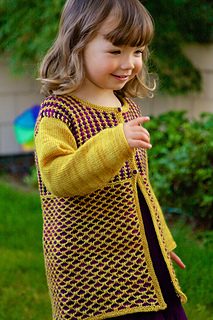patterns > Holli Yeoh >  Holli Yeoh Designs and 1 more...
Holli Yeoh Designs and 1 more...
> Lady Emmeline








Lady Emmeline
Inspiration comes from many places for me. This time I had a swatch of stitch patterns I use as a sample in one of the classes I teach. I just loved how both of these slip-stitch patterns looked together.
One of the stitch patterns resembles small fleurs-de-lis when worked bottom up; the other makes a lovely scalloped lattice pattern when worked top down. To maintain the integrity of these two stitch patterns I realized that I needed to use a provisional cast on so the bodice could be worked upwards and the body could be knit top down. Working through the construction details often plays an important role in my final designs.
Colourwork using slip-stitch patterns feels a little bit like cheating, but I love the effect it achieved here. Felicia of SweetGeorgia Yarns helped choose the colorway and I absolutely adore it. The surprise is that the gold and amethyst colors paired with the detailed-yet-simple stitch patterns evoke the bygone era of rich brocade fabrics worn by upper nobility in medieval times.
Do you like this pattern but which you could make it in your size? You’re in luck! Aquitaine is available in eight women’s sizes ranging from XS to 4X.
Construction Notes
This design is started at the lower edge of the bodice with a provisional cast on. After the bodice is worked, the live sts are retrieved and the body of the cardigan is worked top down. Shaping is achieved by gradually changing needle size when working the body. Sleeves are picked up around the armholes, and worked top down with short rows to create the sleeve cap.
This knitting pattern includes written directions, both charts and written charted instructions, front and back images, a schematic with measurements, and thoughtful details.
Sizes/Finished Measurements
Sizes: 0-6 months (6-12 months, 12-24 months, 2 yrs, 4 yrs)
Finished chest: 20 (20 ¾, 23, 24 ¾, 27)“ / 51 (52.5, 58.5, 63, 68.5) cm
Length: 110 ½ (12, 13 ½, 15, 16 ¾)” / 26.5 (30.5, 34.5, 38, 42.5) cm
Sleeve seam length: 6 ½ (7 ½, 8, 8 ½, 10 ½)“ / 16.5 (19, 20.5, 21.5, 26.5) cm
Intended to be worn with 2 ½ -3 ½” (6.5- 9 cm) positive ease.
Materials
Fingering weight or sock yarn
Main colour: 530 (635, 770, 900, 1105) yd / 485 (580, 705, 825, 1010) m
Contrasting colour: 310 (360, 450, 530, 640) yd / 285 (330, 410, 485, 585) m
3 (4, 4, 5, 5) ½“ (13 mm) buttons
Shown in SweetGeorgia Yarns Tough Love Sock (affiliate link)
Goldmine (MC); 1 (1, 1, 1, 2) skeins
Amethyst (CC); 1 skein for all sizes
Substitution Notes
Choose a fingering or sock weight yarn with easy care instructions. Main colour should be a solid or tonal yarn. Contrasting colour should be either solid/tonal or variegated. If variegated, it shouldn’t contain the exact same colour as the main colour; the colourwork pattern will be difficult to see if the colours are the same. Look for a sharp contrast between the two colours. A trick when picking colours is to use the black and white setting your camera phone to look at the colours side by side; you want them to look different.
Gauge
26 sts and 36 rows = 4 inches in St st using US 3 (3.25 mm) needle
28 sts and 64 rows = 4 inches in Three-and-One pattern using US 3 (3.25 mm) needle
28 sts and 64 rows = 4 inches in Two-Tone Lattice pattern using US 3 (3.25 mm) needle
This design is started at the lower edge of the bodice with a provisional cast on. After the bodice is worked, the live sts are retrieved and the body of the cardigan is worked top down. Shaping is achieved by gradually changing needle size when working the body.
Techniques
Increases/decreases, provisional cast on, bias bind off (instructions included), working simple mosaic knitting (slipped stitches) colourwork from charts or written instructions (no stranding), modified set-in sleeve sweater construction, worked flat, bottom up and top down, seaming for armholes only, picking up stitches, buttonholes and sewing on buttons.
Helpful Links
Raised Increases video tutorial
Raised Increases photo tutorial
SSK & SSP Decreases video tutorial
29914 projects
stashed
27263 times
- First published: January 2013
- Page created: January 14, 2013
- Last updated: March 4, 2025 …
- visits in the last 24 hours
- visitors right now





